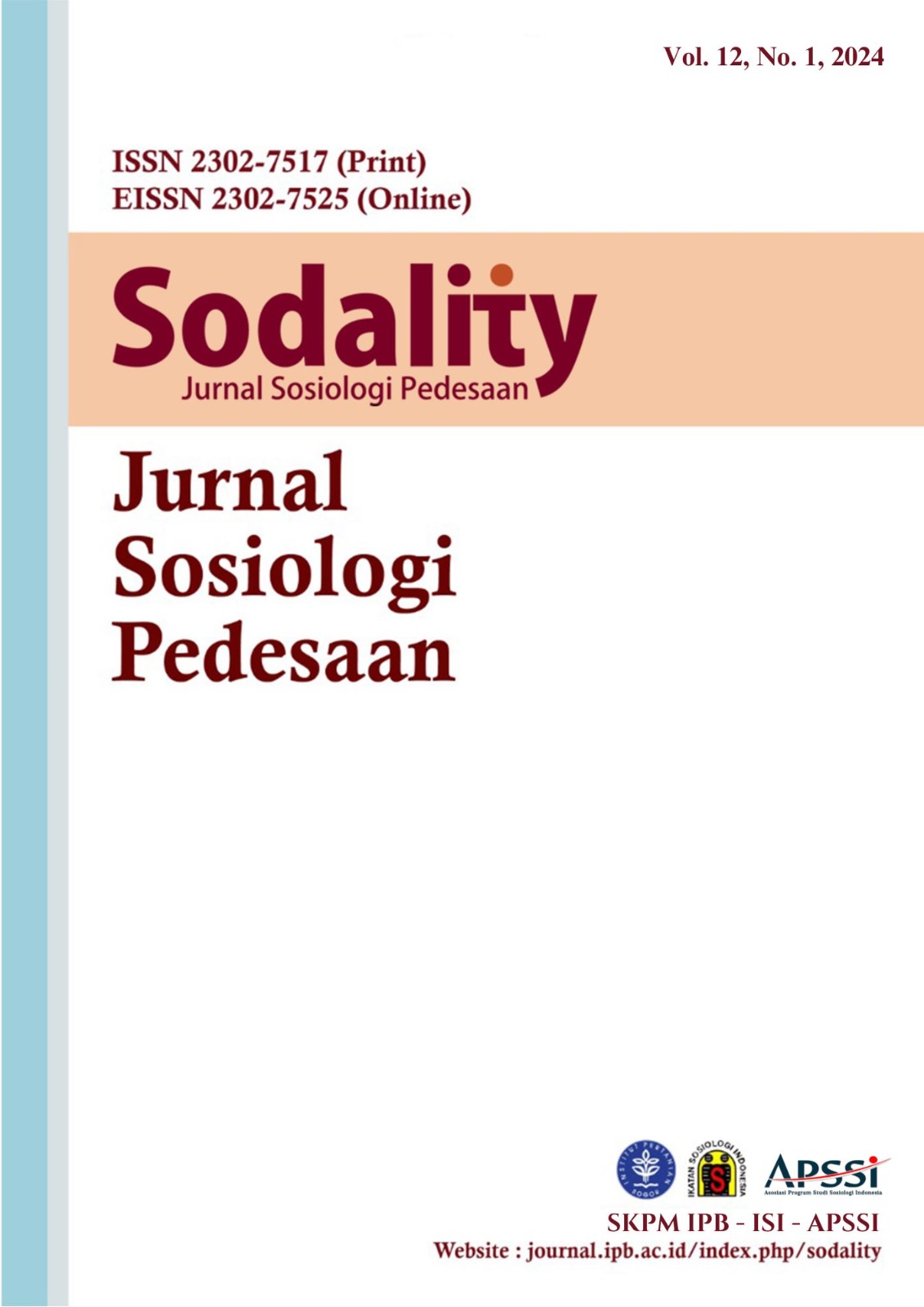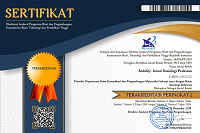Designing a Safe and Friendly Environment for Women and Children in Rural Community
Abstract
The need to build a safe and friendly environment has developed to respond to the increasing number of vulnerable issues which have been faced by children and women. Nevertheless, strategies to build a safe and friendly environment in rural areas are rarely discussed. This study outlined the macro perspective which considers structural and cultural change as a strategy to design a positive environment for women and children in the village. This perspective is adopted due to the fact that the places where women and children live, either in city or rural areas could become the factors causing women and children to live in a vulnerable environment. This design consists of two aspects which are the building of an institutional network and program recommendations. The implementation of an institutional network requires three principles or strategies which are participation, integration between women and children development programs, and involve various parties or community organizations including village government, professionals, scholars, as well as formal dan informal groups which are formed by rural community members, as facilitators and volunteers in the development programs. All these principles should be adopted to undertake program recommendations to meet the rights of children in health, education, legal advice, security, and peace.
References
Andal, A. G. (2022). Children’s Spaces in Coastal Cities: Challenges to Conventional Urban Understandings and Prospects for Child-friendly Blue Urbanism. Children’s Geographies, 20(5), 688–700. https://doi.org/10.1080/14733285.2021.1962515
Ayuningtyas, F., & Riyantini, R. (2017). Implementation of Child-Friendly City (Study of Parent in Tamansari Puri Bali’s Housing Complex). Proceeding The 1st International Conference on Social Sciences. https://jurnal.umj.ac.id/index.php/icoss/article/view/2361
Azhom, A. M. (2021). Realizing a Child Friendly City as Protection towards Children in Indonesia. Constitutionale, 2(2), 89–102. https://doi.org/10.25041/constitutionale.v2i2.2420
Banerjee, A., Duflo, E., Glennerster, R., & Kinnan, C. (2015). The Miracle of Microfinance? Evidence from a Randomized Evaluation. American Economic Journal: Applied Economics, 7(1), 22–53. https://doi.org/10.1257/app.20130533
Bhattacharyya, J. (2004). Theorizing Community Development. Journal of the Community Social Development Society, 34(2), 5–34. https://doi.org/10.1080/15575330409490110
Bijnens, E. M., Derom, C., Thiery, E., Weyers, S., & Nawrot, T. S. (2020). Residential Green Space and Child Intelligence and Behavior across Urban, Suburban, and Rural Areas in Belgium: A Longitudinal Birth Cohort Study of Twins. PLoS Medicine, 17(8), e1003213. https://doi.org/10.1371/JOURNAL.PMED.1003213
Blake, C., Annorbah-Sarpei, N. A., Bailey, C., Ismaila, Y., Deganus, S., Bosomprah, S., Galli, F., & Clark, S. (2016). Scorecards and Social Accountability for Improved Maternal and Newborn Health Services: A Pilot in the Ashanti and Volta Regions of Ghana. International Journal of Gynecology and Obstetrics, 135(3), 372–379. https://doi.org/10.1016/j.ijgo.2016.10.004
Bodner, N., Kuppens, P., Allen, N. B., Sheeber, L. B., & Ceulemans, E. (2018). Affective Family Interactions and their Associations with Adolescent Depression: A Dynamic Network Approach. Development and Psychopathology, 30(4), 1459–1473. https://doi.org/10.1017/S0954579417001699
Buisson, M. C., Clement, F., & Leder, S. (2022). Women’s Empowerment and the Will to Change: Evidence from Nepal. Journal of Rural Studies, 94, 128–139. https://doi.org/10.1016/j.jrurstud.2022.06.005
Campfens, H. ed. (1997). Community Development around the World: Practice, Theory, Research, Training. University of Toronto Press.
Carlsson, G. (1968). Change, Growth, and Irreversibillity. American Journal of Sociology, 73(6), 706-714. https://doi.org/10.1086/224564
Chadwick-Charuma, P. M., Tsvere, M., & Mutopo, P. (2022). Effects of Domestic Violence on Child—A Case Study of Chinhoyi. Open Journal of Social Sciences, 10(10), 203–212. https://doi.org/10.4236/jss.2022.1010014
Chambers, R. (1994). Participatory Rural Appraisal (PRA): Challenges, Potentials and Paradigm. World Development, 22(10), 1437–1454. https://doi.org/10.1016/0305-750X(94)90030-2
Chang, E. S. (2018). Kirogi Women’s Psychological Well-Being: The Relative Contributions of Marital Quality, Mother–Child Relationship Quality, and Youth’s Educational Adjustment. Journal of Family Issues, 39(1), 209–229. https://doi.org/10.1177/0192513X16632265
Chawa, A. F., Al Yusainy, C., Adila, I., & Kusumastuti, A. (2018). Deemphasize Community Development Programs on Migran Workers. Jurnal Terapan Abdimas, 3(2), 170. https://doi.org/10.25273/jta.v3i2.2807
Chawa, A. F., Budi Nugroho, A., & Sutopo, D. S. (2020). Empowering Women Ex-Migrant Workers and Domestic Violence Victims through Komunitas Perempuan Singkong Jaya. Sodality: Jurnal Sosiologi Pedesaan, 8(2), 69–83. https://doi.org/10.22500/8202031910
Das, S., Das, R., Bajracharya, R., Baral, G., Jabegu, B., Odland, J. Ø., & Odland, M. L. (2019). Incidence and Risk Factors of Pre-eclampsia in the Paropakar Maternity and Women’s Hospital, Nepal: A Retrospective Study. International Journal of Environmental Research and Public Health, 16(19), 1–8. https://doi.org/10.3390/ijerph16193571
Deniz, N., Deniz, S., & Ertosun, Ö. G. (2012). The Woman-Friendly Organization-Effects of Demographic Variables on Women Employees’ Perception about Their Companies on Work and Family-Oriented Woman-Friendly HRM: A Study in Banking Industry in Turkey. Procedia - Social and Behavioral Sciences, 41, 477–484. https://doi.org/10.1016/j.sbspro.2012.04.058
Detraz, N., & Peksen, D. (2017). "Women Friendly” Spending? Welfare Spending and Women’s Participation in the Economy and Politics. Politics and Gender, 14, 137–161. https://doi.org/10.1017/S1743923X17000253
Dewi, S. P. (2012). How does the Playground Role in Realizing Children-Friendly-City? Procedia - Social and Behavioral Sciences, 38, 224–233. https://doi.org/10.1016/j.sbspro.2012.03.344
Effendi, R., Herpratiwi, & Sutiarso, S. (2021). Pengembangan LKPD Matematika Berbasis Problem Based Learning di Sekolah Dasar. Jurnal Basicedu, 5(2), 920–929. https://doi.org/10.31004/basicedu.v5i2.846.
Everson, S. (2008). Building Child Friendly Villages: Using Village Strengths to Combat Child Labour and other Exploitative Practices. The Center for Victims of Torture.
Fernandes, A., Krog, N. H., McEachan, R., Nieuwenhuijsen, M., Julvez, J., Márquez, S., Castro, M., Urquiza, J., Heude, B., Vafeiadi, M., Gražulevičienė, R., Slama, R., Dedele, A., Aasvang, G. M., Evandt, J., Andrusaityte, S., Kampouri, M., & Vrijheid, M. (2023). Availability, Accessibility, and Use of Green Spaces and Cognitive Development in Primary School Children. Environmental Pollution, 1(334), 122143. https://doi.org/10.1016/j.envpol.2023.122143
Ghanbari-Azarneir, S., Anbari, S., Hosseini, S.-B., & Yazdanfar, S.-A. (2015). Identification of Child-friendly Environments in Poor Neighborhoods. Procedia - Social and Behavioral Sciences, 201, 19–29. https://doi.org/10.1016/j.sbspro.2015.08.114
Godfrey, E. B., Osher, D., Williams, L. D., Wolf, S., Berg, J. K., Torrente, C., Spier, E., & Aber, J. L. (2012). Cross-national Measurement of School Learning Environments: Creating Indicators for Evaluating UNICEF’s Child Friendly Schools Initiative. Children and Youth Services Review, 34(3), 546–557. https://doi.org/10.1016/j.childyouth.2011.10.015
Hashim, R., & Yussof, H. (2017). Humanizing Humanoids Towards Social Inclusiveness for Children with Autism. Procedia Computer Science, 105, 359–364. https://doi.org/10.1016/j.procs.2017.01.234
Hasriadi, & Malino, T. M. M. (2020). Towards Child-Friendly Indonesia: Series 2 Policy Advocacy for the Fulfillment of Children’s Rights and Protection. Yayasan Wahana Visi Indonesia.
Hawkes, S., Pantazis, A., Purdie, A., & Gautam, A. (2022). Sex Disaggregated Data Matters: Tracking the Impact of COVID 19 on the Health of Women and Men. Economia Politica, 39(1), 55–73. https://doi.org/10.1007/s40888-021-00254-4
Hernes, G. (1976). Structural Change in Social Processes. American Journal of Sociology, 82, 513–547. https://doi.org/10.1086/226352
Hillis, S., Mercy, J., Amobi, A., & Kress, H. (2016). Global Prevalence of Past-year Violence against Children: A Systematic Review and Minimum Estimates. Pediatrics, 137(3). https://doi.org/10.1542/peds.2015-4079
Hwang, W. (2019). The Effects of Family-Friendly Policies and Workplace Social Support on Parenting Stress in Employed Mothers Working Nonstandard Hours. Journal of Social Service Research, 45(5), 659–672. https://doi.org/10.1080/01488376.2018.1501790
Ilyasa, R. M. A. (2021). Legal and Victimological Perspective on Sexual Violence against Children Cases in Indonesia. The Indonesian Journal of International Clinical Legal Education, 3(3), 281–300. https://doi.org/10.15294/ijicle.v3i3.48269
Innes, S. L., & Rayment-McHugh, S. (2023). It’s More Than a Matter of Trust: What Parents and Young Children Need to Know to Prevent Intrafamilial Child Sexual Abuse. Journal of Child Sexual Abuse, 33(1), 43–64. https://doi.org/10.1080/10538712.2023.2291396
Islam, M. S. (2019). An Assessment of Child Protection in Bangladesh: How effective is NGO-led Child-Friendly Space? Evaluation and Program Planning, 72, 8–15. https://doi.org/10.1016/j.evalprogplan.2018.09.003
Jansson, M., Sundevall, E., & Wales, M. (2016). The Role of Green Spaces and their Management in a Child-friendly Urban Village. Urban Forestry and Urban Greening, 18, 228–236. https://doi.org/10.1016/j.ufug.2016.06.014
Karamouzian, M., Foroozanfar, Z., Ahmadi, A., Haghdoost, A. A., Vogel, J., & Zolala, F. (2016). How Sex Work becomes an Option: Experiences of Female Sex Workers in Kerman, Iran. Culture, Health and Sexuality, 18(1), 58–70. https://doi.org/10.1080/13691058.2015.1059487
KEMENPPPA. (2011). Peraturan Menteri Negara Pemberdayaan Perempuan dan Perlindungan Ana Republik Indonesia Nomor 12 Tahun 2011 tentang Indikator Kabupaten/Kota Layak Anak.
Kenny, S. (2006). Developing Communities: For the Future. Thomson.
Khalili, A., & Fallah, S. N. (2018). Role of Social Indicators on Vitality Parameter to Enhance the Quality of Women’s Communal Life within an Urban Public Space (Case: Isfahan's traditional bazaar, Iran). Frontiers of Architectural Research, 7(3), 440–454. https://doi.org/10.1016/j.foar.2018.06.001
Koehler, G. (2016). Tapping the Sustainable Development Goals for Progressive Gender Equity and Equality Policy? Gender and Development, 24(1), 53–68. https://doi.org/10.1080/13552074.2016.1142217
Kusmanto, T. Y., & Elizabeth, M. Z. (2018). Struktur dan Sistem Sosial pada Aras Wacana dan Praksis. Jurnal Sosiologi Walisongo, 2(1), 39–50. https://doi.org/10.21580/jsw.2018.2.1.2252
Larner, S. (2022). Facilitating Children’s Informal Disclosures of Sexual Abuse: The Role of Online Counsellors at a National Children’s Helpline. Journal of Child Sexual Abuse, 31(3), 276–296. https://doi.org/10.1080/10538712.2022.2047854
Lenton, S., & Ehrich, J. (2015). Approach to Child-friendly Health care - The Council of Europe. Journal of Pediatrics, 167(1), 216–218. https://doi.org/10.1016/j.jpeds.2015.04.001
Li, M., & Li, J. (2017). Analysis of Methods of Allocating Grass Space for the Design of Child-friendly Cities: A Case Study of Changsha. Procedia Engineering, 198, 790–801. https://doi.org/10.1016/j.proeng.2017.07.130
Lugosi, P., Golubovskaya, M., Robinson, R. N. S., Quinton, S., & Konz, J. (2020). Creating Family-friendly Pub Experiences: A Composite Data Study. International Journal of Hospitality Management, 91, 1–24. https://doi.org/10.1016/j.ijhm.2020.102690
Lysova, A., Hanson, K., & Hines, D. A. (2023). "How can I be a Victim when I have Children?” Abused Men’s Perceptions of their Children’s Exposure to Domestic Violence. Journal of Aggression, Maltreatment and Trauma, 33(1), 67–84. https://doi.org/10.1080/10926771.2023.2186300
Malamassam, M. A. (2014). Women Labor Migration in Asia: Mother Migration and its Impact on Left-Behind Children. Jurnal Kependudukan Indonesia, 9(1), 1–10. https://doi.org/DOI: 10.14203/jki.v9i1.108
Merrick, M. T., Ports, K. A., Ford, D. C., Afifi, T. O., Gershoff, T., & Grogan-kaylor, A. (2017). Unpacking the Impact of Adverse Childhood Experiences on Adult Mental Health. Child Abuse & Neglect, 69, 10–19. https://doi.org/10.1016/j.chiabu.2017.03.016
Meyer, S. R., & Stark, L. (2022). Development of an Index to Measure the Strength of Child Protection Systems in Refugee Settings: Conceptual and Practical Considerations. Child Abuse and Neglect, 134, 105920. https://doi.org/10.1016/j.chiabu.2022.105920
Mhattir, N. Z. (2022). Bukan Banyuwangi, Ini Kabupaten Penyumbang TKI Terbanyak di Jawa Timur, Pantesan Pada Kaya. https://www.jatimnetwork.com/jatim/pr-435917066/bukan-banyuwangi-ini-kabupaten-penyumbang-tki-terbanyak-di-jawa-timur-pantesan-pada-kaya
Mitchell, J. M., Becker-blease, K. A., Soicher, R. N. (2021). Child Sexual Abuse, Academic Functioning and Educational Outcomes in Emerging Adulthood. Journal of Child Sexual Abuse, 30(3), 278-297. https://doi.org/10.1080/10538712.2020.1847228
Mordeno, I. G., Galela, D. S., Nalipay, J. N., & Cue, M. P. (2018). Centrality of Event and Mental Health Outcomes in Child and Adolescent Natural Disaster Survivors. Spanish Journal of Psychology, 21, 1–8. https://doi.org/10.1017/sjp.2018.58
Movshovich, J. (2015). Children’s Participation in Society; a Key to Development: Children as Essential Actors in Improving their Lives and Communities. https://dumas.ccsd.cnrs.fr/dumas-01140059
Nana, D. (2017). Inilah 5 lumbung TKI Kabupaten Malang. https://www.malangtimes.com/baca/16514/19700101/000000/inilah-5-lumbung-tki-kabupaten-malang
Paulus. (2022). Ini 10 Provinsi Penyumbang TKI Terbesar. https://www.victorynews.id/ekonomi/pr-3315361312/ini-10-provinsi-penyumbang-tki-terbesar-september-2022-ada-jawa-timur-dan-ntb
Peters, P., Harding, C., Forde, S., Heckendorf, N., & Seal, A. (2022). Exploring Barriers to Domestic Violence Screening among Culturally and Linguistically Diverse and Migrant Women in a Regional Midwifery Setting. Midwifery, 114, 103454. https://doi.org/10.1016/j.midw.2022.103454
Prati, G. (2017). Gender Equality and Women’s Participation in Transport Cycling. Journal of Transport Geography, 14(1), 369–375. https://doi.org/10.1016/j.jtrangeo.2017.11.003
Putri, R., Astuti, W., & Rahayu, M. (2016). Community Capacity in Providing Neighborhood Unit-Scale Social Infrastructure in Supportin Surakarta Child Friendly. Procedia - Social and Behavioral Sciences, 227, 536–544. https://doi.org/10.1016/j.sbspro.2016.06.112
Raharto, A., Daliyo, Alihar, F., Graeme J, . Hugo, Romdiati, H., Noveria, M., Mujiyani, Bandiyono, S., & Soewartoyo. (2002). Kebutuhan Informasi bagi Tenaga Kerja Migran Indonesia: Studi Kasus di Provinsi Jawa Barat, Kalimantan Timur dan Riau. Pusat Penelitian Kependudukan–Lembaga Ilmu Pengetahuan Indonesia.
Raharto, A., & Noveria, M. (2012). Advocacy Groups for Indonesian Women Migrant Workers Protection. Jurnal Kependudukan Indonesia, 7(1), 1–18. https://doi.org/10.14203/JKI.V7I1.80
Riddell, S., & Weedon, E. (2017). Social Justice and Provision for Children with Additional Support Needs in Scotland. Education, Citizenship and Social Justice, 12(1), 36–48. https://doi.org/10.1177/1746197916683469
Schmitt, M. L., Clatworthy, D., Ogello, T., & Sommer, M. (2018). Making the Case for a Female-friendly Toilet. Water, 10(9), 1193. https://doi.org/10.3390/w10091193
Sinharoy, S. S., Waid, J. L., Ali, M., Yount, K. M., Thilsted, S. H., & Webb, A. (2019). Resources for Women’s Agency, Household Food Security, and Women’s Dietary Diversity in Urban Bangladesh. Global Food Security, 23, 1–8. https://doi.org/10.1016/j.gfs.2019.03.001
Smelser, N. J. (1998). The Handbook of Sociology. SAGE.
Stone, U., Liddell, M., & Martinovic, M. (2017). Incarcerated Mothers: Issues and Barriers for Regaining Custody of Children. Prison Journal, 97(3), 296–317. https://doi.org/10.1177/0032885517703957
Suryadi, Kasturi, & Yusmanto. (2022). Pekerja Migran Indonesia dan Potensi Masalah Keluarga yang Ditinggalkan (Family Left-Behind. JURNAL EMPOWER: Jurnal Pengembangan Masyarakat Islam, 7(1), 126–141. https://doi.org/10.24235/empower.v7i1.10408
Tolulope, G., Abiodun, A., & Michael, F. (2021). Women Participation in Community and Social Development Project ( CSDP ) in Ondo State.
Topal, A. (2019). Economic Reforms and Women’s Empowerment in Saudi Arabia. Women’s Studies International Forum, 76(3). https://doi.org/10.1016/j.wsif.2019.102253
UN Women. (2021a). Christian Communities in Fiji Use Faith-Based Approaches to Prevent Violence Against Women. https://www.unwomen.org/sites/default/files/2021-11/UN-Women-impact-story-Fiji-Christian-communities-use-faith-based-approaches-to-prevent-violence-en.pdf
UN Women. (2021b). Police Units for Women Victims of Violence in Morocco Prioritize Survivors’ Needs. https://www.unwomen.org/sites/default/files/2021-11/UN-Women-impact-story-Morocco-Police-units-for-women-victims-of-violence-prioritize-survivors-en.pdf
UN Women. (2021c). Raising Awareness on Domestic Violence in Haiti. https://www.unwomen.org/sites/default/files/2021-11/UN-Women-impact-story-Haiti-Raising-awareness-on-domestic-violence-en.pdf
UN Women. (2021d). Roma Women Contribute to Making Cities Safer in Eastern Ukraine. https://www.unwomen.org/sites/default/files/2021-11/UN-Women-impact-story-Eastern-Ukraine-Roma-women-contribute-to-making-cities-safer-en.pdf
UNICEF. (2024). Minneapolis, Minnesota Recognized as the Second UNICEF Child Friendly City in the United States. https://www.unicef.org/childfriendlycities/stories/minneapolis-minnesota-recognized-second-unicef-child-friendly-city-united-states
UNICEF. (2018). What is the Child Friendly Cities Initiative? https://childfriendlycities.org/what-is-the-child-friendly-cities-initiative/
UNICEF. (2020). Childs Friendly Cities and Community. UNICEF.
UNICEF. (2023). Half of the Children in Spain Live Today in a Child-Friendly City. https://www.unicef.org/childfriendlycities/stories/half-children-spain-live-today-child-friendly-city
Wei, J., Wu, Y., Zheng, J., Nie, P., Jia, P., & Wang, Y. (2021). Neighborhood Sidewalk Access and Childhood Obesity. Obesity Reviews, 22(S1), e13057. https://doi.org/10.1111/obr.13057
Whyte, W. F. (1997). Creative Problem Solving in the Field: Reflections on a Career. AltMira Press.
Wulan, T. R., Shodiq, D., Wijayanti, S., Woro, D., Lestari, D., Tri, A., Wahyuningsih, E., & Restuadhi, H. (2018). Ayah Tanguh, Keluarga Utuh: Pola Asuh Ayah pada Keluarga Buruh Migran Perempuan di Kabupaten Banyumas. Jurnal Ilmu Keluarga & Konsumen, 11(2), 84–95. https://doi.org/10.24156/jikk.2018.11.2.84
Yamin, M. (2016). Kota Ramah Anak: Apa, Mengapa, Bagaimana.. https://www.kemenpppa.go.id/index.php/page/read/31/612/kota-ramah-anak-apa-mengapa-bagaimana
Yoeti, A. O. (1996). Pengantar Ilmu Pariwisata. Angkasa, Bandung.
Zyl, B., Cilliers, J., & Lategan, L. (2022). Spatial Planning Guidelines for Child-friendly Spaces: An African Perspective. Rural Society, 31(3), 179–195. https://doi.org/10.1080/10371656.2022.2151137
Authors who publish with this journal agree to the following terms:
- Authors retain copyright and grant the journal right of first publication with the work simultaneously licensed under a

This work is licensed under a Creative Commons Attribution 4.0 International License. that allows others to share the work with an acknowledgement of the work's authorship and initial publication in this journal. - Authors are able to enter into separate, additional contractual arrangements for the non-exclusive distribution of the journal's published version of the work (e.g., post it to an institutional repository or publish it in a book), with an acknowledgement of its initial publication in this journal.
- Authors are permitted and encouraged to post their work online (e.g., in institutional repositories or on their website) prior to and during the submission process, as it can lead to productive exchanges, as well as earlier and greater citation of published work (See The Effect of Open Access).





.png)










